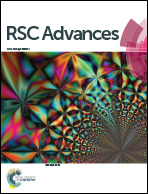Chemical substitution assisted ion sensing with organic molecules: a case study of naphthalene
Abstract
The chemical modification effects on the electron transport of organic molecules are investigated using first-principles calculations combined with a non-equilibrium Green’s function technique, taking the naphthalene (C10H8) molecule as an example. Particularly, one of the –CH groups in each of the benzene rings is replaced by a N atom. It is found that N substitution greatly increases the quantum conductance by ∼80% due to the reduced HOMO (Highest Occupied Molecular Orbital)–LUMO (Lowest Unoccupied Molecular Orbital) gap and the increased charge transfer from the leads to the molecule. More interestingly, the adsorption of different monovalent cations (H+, Li+, Na+, and K+) to the chemically active N site induces a very different electrical response. To be specific, Li+, Na+, and K+ adsorptions result in a very good conducting state, while H+ adsorption gives rise to an insulating state, providing a promising method for H+ sensing or detection.


 Please wait while we load your content...
Please wait while we load your content...